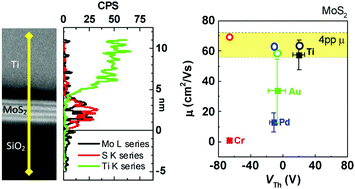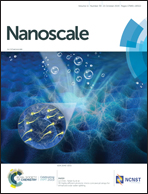Metallic contact induced van der Waals gap in a MoS2 FET†
Abstract
Electrical metal contacts formed with 2D materials strongly affect device performance. Here, we used scanning transmission electron microscopy (STEM) and energy-dispersive spectroscopy (EDS) to characterize the interfacial structure formed and physical damage induced between MoS2 and the most commonly used metals, Ti, Cr, Au, and Pd. We further correlated the electrical performance with physical defects observed at the 2D interfacial structure. The contact resistances were higher in the order of Ti, Au, Pd, and Cr contacts, but all 4-point probe mobilities measured with metals in contact with identical quadrilayer MoS2 were ∼65 cm2 V−1 s−1, confirming the reliability of the devices. According to the STEM and EDS analyses, the Ti contact gave rise to a van der Waals gap between the clean quadrilayer MoS2 and the Ti contact. By contrast, Cr migrated into MoS2 while Mo and S counter-migrated into the SiO2 substrate. Au and Pd formed glassy layers that resulted in the migration of Mo and S into the Au and Pd electrodes. These interfacial structures between MoS2 and contact metals strongly correlated with the electrical performance of 2D MoS2 FETs, providing practical guidelines to form van der Waals contacts.



 Please wait while we load your content...
Please wait while we load your content...